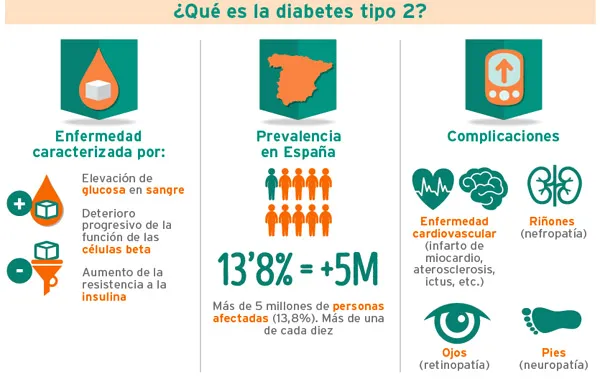An epidemiological study updates the incidence of type 2 diabetes in Spain, placing it in 11.6 cases per 1000 people, as it has just been presented at the thirst congress.
The incidence of diabetes is located in Spain in 11.58 cases for every 1000 people and year, according to a novel and expected study, driven by the cyber of diabetes and associated metabolic diseases (cyberdem), which has just been presented at the XXIX CongressNational of the Spanish Diabetes Society (SED), in Oviedo.
According to these data, there are almost 400.00 people, specifically, 386.003 that develop this metabolic disease in Spain every year.
This prospective cohorts study is the first designed with the objective of determining in the adult population the prevalence and incidence of type 2 diabetes throughout Spain and the publication of its results was highly anticipated by experts.
The work comes to fill a hole on which the specialists had warned, since you could only work so far with local data.The work had a first phase that was carried out between 2008 and 2010 in a sample of 5,072 adults of the Spanish population, over 18, randomly selected and from 110 primary care centers.
Anna Novials, president of the Spanish Society of Diabetes and specialist at the Clinical Hospital, of Barcelona, has highlighted the importance of the study, "with very important results for its socio -health impact and because they will help us better adjust the preventive measures of diabetes in Spain"
GEMMA Red, specialist at the Regional Hospital of Malaga and coordinator of the study, in which she has participated about thirty people has stressed that this data of 11.6 cases "is more or less expected. The important thing is that we now have a photo ofThe whole country.
This incidence of 11.6 cases per 1000 inhabitants "is not too high but is not low and what confirms that we are facing an important health problem on which it is necessary to make decisions. And the health authority now has more data to do so"
Red Gemma has also indicated the importance of studies that are already being carried out continuity of this initial to analyze in more detail the risk factors and seek blood markers "that allow us to determine on which population we have to intervene or we must do it withmore intensity ".Also genetic, epigenetic and biochemical studies will help in this goal.
For the study, the country has been divided is six geographical areas.Anna Novials influenced the importance of seeing the evolution of the disease in the different autonomous communities and also, among other aspects, of being able to perform an estimate of how many people diabetics are going to become in Spain in the coming years.
The study does not reflect very different data by autonomous communities in terms of incidence but something in terms of prevalence, which is superior in areas such as Andalusia and the Canary Islands.
In 2012, the results were published, which established a diabetes prevalence of 13.8 percent, which implied that about 4 million Spaniards suffered from type 2 diabetes, and throughout 2016-2017 the same cohort has re-evaluatedPopulation, with the study of 2,048 people who did not present diabetes in the initial study.
The study has served to verify that the incidence of diabetes is higher in men than in women and that in them increases with age since the age of 18, with a maximum in the 75, while in women the incidence grows continuously withAge.
AnalysisSubsequent of the evaluated variables will allow to determine the risk factors associated with the development of diabetes, as well as the incidence of associated comorbidities.In the study, anthropometric variables, such as weight, body mass index, waist and hip circumference, waist/ hip-hip-variable index, healthy habits such as physical activity such as physical activity such as smoking or intake ofAlcohol, use of drugs, eating habits and also the presence of pathologies associated with diabetes such as hypertension, dyslipemia, as well as multiple biochemical variables.


